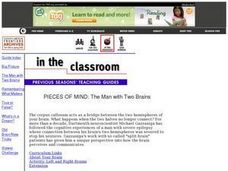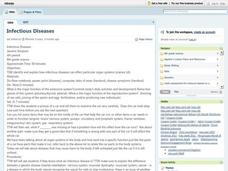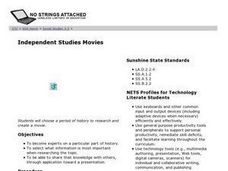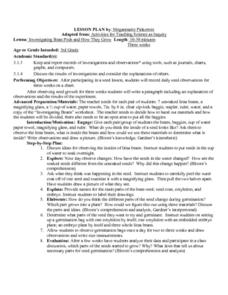Curated OER
Using Information Resources: Lesson 4
Fourth graders review a variety of information resources and identify parts of a book. They practice brainstorming and practice skimming. They review all the research resources that are found in the library.
Curated OER
Taking Apart Electrical Appliances
Students discover that electrical appliances are made up of individual components that work together. They, with partners, demonstrate to others how their piece of equipment or appliance works by taking it apart and examining the parts.
Curated OER
Left and Right Brains
Learners research the part of the brain known as the corpus callosum. The part of the brain that connects the left and right brain, students investigate its functions and how data passes from one side to another.
Curated OER
Aerobic and Anaerobic Conditioning
Students view the A.D.A.M. computer simulation of aerobic and anaerobic exercise. They break into groups and members brainstorm and list as many aerobic and anaerobic exercises as possible in five minutes.
Curated OER
Infectious Diseases
Eighth graders identify and explain how infectious diseases effect organ systems. Using an analogy with automobiles and body systems, they discover how one part influences the operation of the whole. Students write paragraphs about...
Curated OER
Stop the Bleeding
Students explore various parts of the heart and blood vessels . They begin with an overview of the components of the cardiovascular system. They see a cross section of an artery and watch how a blood clot develops.
Curated OER
Brush Up On Your Teeth
Third graders examine the reasons why it is important to take care of their teeth. As a class, they sing the toothbrush song and read about tooth decay. They identify the parts of the teeth and identify foods that can keep the mouth...
Curated OER
The Preposition Song
Students, after watching and listening to a video on Grammar Rock, recite and sing the words to The Preposition Song. They rehearse it several times before they stand up in front of class and recite it out loud for their classmates as...
Curated OER
Using Prepositions #2
Students practice using prepositions related to movement in written and verbal form. They use the internet to help them create a reference sheet. They complete a worksheet to end the lesson plan.
Curated OER
Land Use Issues
Students discover seeds are a source of life. They also label the parts of a seed and examine the conditions which are needed for the seed to start growing. They follow the life cycle of seeds.
Curated OER
Vocabulary Cards
Students in an ESL classroom are introduced to new vocabulary for a new section. As a class, they are dealt an index card with an envelope with a vocabulary word on the outside. They practice writing new sentences with the new vocabulary...
Curated OER
Making Books
Students make a variety of books using the computer program iPhoto and digital images of their choosing. This lesson for the upper-elementary classroom includes an example of student work and four possible lesson extensions and...
Curated OER
Poem Movies
Students create iMovie presentations that represent favorite poems chosen by the students in this language arts lesson for the upper-elementary classroom. The lesson includes resource links to find poetry and requires computers and movie...
Curated OER
Student Dictionary
Third graders practice dictionary skills. They use a digital camera and insert pictures from a floppy disk into a document. They play a game in which they are handed an anonymous definition of each other and must find each other in class.
Chicago Botanic Garden
Preparing for Project BudBurst
Plants take cues from the environment—change in daylight hours and temperature—to complete their seasonal life cycles. Lesson four in the series of six has classes collect phenology data on plants. After taking initial observations,...
Cornell University
Atomic Bonding
Explore the connection of surface area to bonding within atoms. Learners complete lab investigations to model changing surface area with different sizes and concentrations of atoms. A flour fireball demonstration follows the labs to...
Curated OER
Can You Name That Shape?
Learners use materials to build, investigate, and draw two-dimensional shapes (polygons). They combine the shapes they have built and draw from the pile to begin a round-robin activity to name and determine the attributes of a selection...
Polar Trec
Nature's Density Column
Nature provides density columns in the polar regions that provides food for many animals. Young scientists build their own density columns with water in order to answer analysis questions. Through a slideshow presentation, scholars...
Curated OER
Making the Most of the Internet
Children listen as the teacher tells them about Childnet. Students use the CD-ROM and internet sites to answer questions on the worksheets. Students learn to navigate the sites and search techniques. If time and interest allows, an...
Curated OER
Independent Studies Movies
History comes alive as groups work cooperatively to create short iMovies about a specific historical period of their choice. Ideal for late elementary grades, the lesson plan includes a video demonstration and a short materials list.
Curated OER
Investigating Bean Pods and How They Grow
Third graders observe and create a record of seed growth over time. After planting a seed, 3rd graders record their observations of the seed's growth over a three week period. Upon conclusion of the experiment, they write a paragraph...
Curated OER
Biology - Virus Modeling
Students research one of the many types of viruses. They create a 3-D model of the virus they researched with graphics software.
Curated OER
Moving and Growing
Students explore the types of skeletons in various animals. In this skeletal systems lesson plan, students watch a video clip about skeletons, view a human skeleton, compare the skeletons of humans, chickens and fish, and learn about...
Curated OER
Ziplock Chemistry
Students investigate various chemical reactions when creating mixtures in ziplock baggies. In this chemistry lesson, students will recognize various chemical reactions and cite evidence. Safety and assessment strategies are included in...























